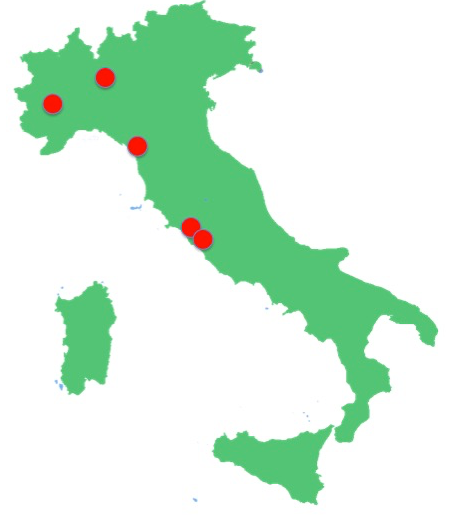Scientific activities of the various Research Units
LNF
We study strongly coupled gauge theories with a special interest in their phase structure and phase transitions. Specific projects include the analysis of the transition from ordinary matter to the plasma of quark and gluons, the nature of the plasma and its spectral features, the conformal transition and its precursory effects. These studies have applications to the physics of ultrarelativistic heavy ion collisions, and to extensions of the standard model with composite Higgs.Milano
We are interested in understanding bosonic degrees of freedom in theories where the fundamental fields are fermionic. We believe that this can help us to understand QCD transitions at high temperature and density. The fundamental progress, obtained during the past years in the theory of critical phenomena within the statistical mechanics of systems in thermodynamical equilibrium, is pushing us towards the possibility of understanding the critical behavior of collective systems under more extreme conditions, which are, nonetheless, of larger practical application. We are thinking to: A) models where invariance under translations is lost, as, in particular, it occurs on a generic graph (walks, trees and forests, matching and dimer coverings), or, in presence of disorder, as in the most celebrated case of spin glasses; B) models in which the distribution probability is stationary but not in thermodynamical equilibrium, which is to say that it is not a Gibbs distribution, but it has to be recovered directly from the given dynamics.Pisa
We are interested in searching for physical phenomena arising at the macroscopic level in many-body systems by studying the physics governing the elementary constituents of the system. A particularly appealing instance of it is the physics across phase transitions. In this context we are currently studying quantum transitions that are relevant for recent experiments, such as those with cold atoms. Also the O(3) non-linear sigma model in 2D with a topological term is studied, in particular its spectrum across the transition at theta=pi. This model is related to the quantum Hall effect. We are also developing a simulation algorithm for 4D causal dynamical triangulations. A phase in the parameter space seems to exist that describes 4D gravity.Roma I
The group at Sapienza, Rome, is involved in several research projects in the physics of complex systems in general, using novel creative numerical and theoretical tools at the frontier of European research. Essentially, three different research lines are pursued: 1) Analysis of the behavior of quantum systems close to a first-order or second-order zero-temperature phase transition. 2) Analysis of the critical behavior of systems with quenched disorder. 3) Study of soft-matter systems using coarse-grained models, obtained by integrating out the (irrelevant) short-scale degrees of freedom, in the spirit of the renormalization group.Torino
Our main research topics are: lattice gauge theory, effective string actions, integrable models, AdS/CFT and the ODE/IM correspondence. One of our main objectives is to test the effective string predictions for the infrared behaviour of lattice gauge theories by means of both analytic calculations and extensive numerical simulations We also study the links between integrable models and other branches of modern physics and mathematics. Within the AdS/CFT framework, integrability arises as a quantum symmetry of operator mixing in N=4 super Yang-Mills in 4 dimensions and other gauge theories in 2 and 3D, while the ODE/IM correspondence links spectral problems for Ordinary Differential Equations to Integrable Models.^ Back to Top


